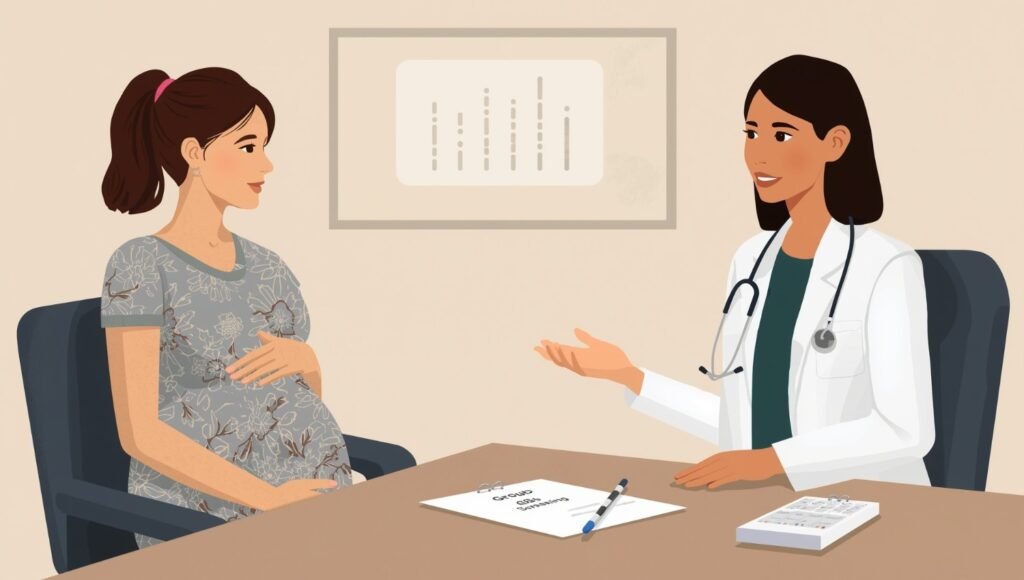Understanding the Risks and Screening
When I first learned about pregnancy, I remember feeling a mix of anticipation, excitement, and even a little concern—feelings many parents share when they hear about Group B strep. It’s a common bacterium, sometimes called a bug, that can live quietly in the vagina or rectum. In fact, about 2–4 in 10 women—roughly 20–40% in the UK—carry it without any obvious symptoms. It’s not a sexually transmitted disease, and most of the time it’s benign, but in rarely seen situations it may be harmful to a baby at birth, leading to serious infection in a newborn. Doctors, including OBs, stress the value of routine screening, especially as labour approaches, because prevention is always better than reaction.
From my own experience supporting expectant mothers, I’ve seen how the word GBS can trigger anxieties, but staying calm and practicing vigilance helps. With modern science and proven strategies, such as screening and prevention, the signs can be caught early, keeping both the mother’s well-being and the baby’s safety on the radar. Whether the bacteria seem silent or more obvious, parents who feel empowered, confident, and well supported are better able to face these risks. It’s true that some infections may be dangerous for babies, but with timely medical care, parents can trust that they are not alone in this journey.
What Is Group B Strep in Pregnancy?
When people talk about Group B Strep in pregnancy, they are referring to Group B Streptococcus (GBS), a bacterium that lives in the digestive and genital tracts of many adults. About 25%, or a quarter, of pregnant women may carry it at some point. Most will never notice a sign, any discomfort, or anything unusual because this is often an asymptomatic colonization where the body and the germ keep a quiet truce. Unlike an obvious illness, GBS usually stays hidden—until childbirth, when it may be transferred to the baby and cause severe infections such as sepsis, pneumonia, or meningitis, which affect the tissues around the brain and spine.
This is why extra attention is given to GBS: even though most babies remain healthy, the complications can be serious. Preventing a newborn infection can be truly life-changing. The digestive system, rectum, and vagina are all areas where it may be found. The American Pregnancy Association estimates that about 25% of healthy, yet often asymptomatic, women carry it. That’s why physicians screen mothers during prenatal care, and if needed, provide treatment with antibiotics (reference 1).
How do doctors test for GBS?

Doctors use a simple test to check for GBS. Women are usually screened between weeks 35 and 37 of pregnancy. The vagina and rectum are swabbed, and the sample is sent to a lab where it is analyzed. The process is quick, and results are often ready within 24-48 hours.
In some cases, women may be treated for GBS even before a positive culture is obtained. The American Academy of Pediatrics recommends that women with certain risk factors—such as premature labor—should be promptly treated (reference 1).
Which women are most likely to pass GBS to their babies?
Testing positive for GBS does not always mean it will be transmitted to the baby. But some risk factors increase the chance of transmission. These include premature rupture of membranes, going into labor before 37 weeks of pregnancy, having a fever, or an interval longer than 18 hours between the water breaking and delivery.
A urinary tract infection (UTI) with GBS during pregnancy also increases risk. Having a prior baby who contracted GBS makes it more likely as well (reference 1).
How is GBS treated in pregnant women?

If a screening test shows that a mother has Group B Strep, medical professionals usually recommend IV antibiotic treatment during delivery. This helps prevent transmission to the baby.
Some women with added risk factors may be treated earlier. But since the vaginal area can re-colonize with GBS, giving antibiotics too early in labor is less effective in preventing infection (reference 1).
What happens if GBS is passed on to a newborn?
If GBS reaches the baby, it can cause serious complications at birth, leading to injuries from infections such as sepsis, pneumonia, or meningitis. It may also affect the heart, blood pressure, and respiratory function. Problems can involve the gastrointestinal system and kidneys. In the long term, if untreated or improperly treated, babies may suffer permanent health conditions or disabilities like brain damage, neonatal encephalopathy, or hypoxic-ischemic encephalopathy (HIE) (reference 2). Other possible outcomes include cerebral palsy, hearing loss, or blindness (reference 3).
When an infection is suspected, antibiotics are used to control it. Signs and symptoms may include an unresponsive or floppy baby who may fail to eat, struggle to breathe, seem irritable, or have an abnormal body temperature, heart rate, or breathing rate. Complications are often preventable with antibiotics. Still, about 5% of infected babies may die (reference 3). Many others survive with conditions like cerebral palsy. That is why routine testing, timely treatment, and appropriate care are critical to prevents harm (reference 4).
About the HIE Help Center and ABC Law Centers
If your child was injured at birth because of complications from GBS or HIE, the Help Center with ABC Law Centers may be a place to turn. This medical malpractice firm focuses only on cases related to birth injuries, and their lawyers bring 100+ years of combined experience in law. They’ve been advocating for disabled children since the firm’s inception in 1997.
If you suspect negligence, you can contact them about pursuing a case. They provide free legal consultations, explain options, and work toward a fair settlement. You won’t pay unless the case is successful, and they also share individualized medical advice and resources to guide families.
Symptoms
Many babies who develop GBS infection show signs within the first week of life—this is called early-onset, often starting in 12–24 hours after birth. Less commonly, late-onset appears around 3 months old. While antibiotics during labour can prevent early-onset, they don’t stop late-onset.
Signs include grunting, noisy breathing, or moaning with effort in the chest or tummy. Some may be sleepy, unresponsive, crying inconsolably, or floppy. Problems with feeding milk, changes in temperature, skin colour that looks blotchy, or abnormally fast or slow heart rate, breathing rate, low blood pressure, or low blood sugar are also red flags. A healthcare professional should be told immediately, as a quick diagnosis and treatment make the difference between recovery and a fatal delay.
Treatment
When a newborn baby shows signs of infection, tests for GBS are run. A sample of blood or fluid from the spinal cord may be taken by lumbar puncture and carefully discussed with parents.
Babies are then treated with antibiotics, which can be truly life-saving. If infection is only suspected, care begins right away and is stopped if tests are negative after at least 36 hours.
Can I still breastfeed?
Yes, you can breastfeed your baby, and it is considered safe. Breastfeeding does not raise the risk of infection and actually brings many benefits to both the mother and child.
How Common Is Group B Strep During Pregnancy?
The prevalence of Group B strep in pregnancy changes depending on geographic area, maternal background, and screening protocols. Research shows the rate is usually 10%–25%, though in some populations colonization can reach 40%.
That means for every ten expectant parents, at least one or two may silently carry GBS. Most mothers and their newborn remain healthy, but knowing your status helps your care team plan your delivery so it’s safely managed.
How Does Group B Strep Spread and Affect Pregnancy?
GBS usually lives in the digestive tract, or gut, but sometimes moves to the vaginal or rectal areas. During childbirth, through the birth canal or amniotic fluid, the mother who carries this bacterium may pass the microbe to the baby.
Not every exposure causes illness: out of 100 babies, only one or two may develop infection, while most become harmless carriers. The risk rises if a baby is born prematurely (before 37 weeks), if the membranes have been ruptured for over 18 hours, or if the mother has fever or a sibling with GBS disease. These are important risk factors to watch.
Risks for Mother and Baby: What Should You Look Out For?

For most, Group B strep pregnancy goes smoothly, but some women do face complications. These can include urinary tract infections, or more rarely, infections like chorioamnionitis (affecting the membranes around the baby), fever during labor, or endometritis (infection of the uterine lining postpartum).
Discharge, pelvic pain, or other unusual symptoms require quick medical attention. It’s not always GBS at fault, but such signs should never be ignored, since catching issues early is key to keeping care routine.
Risks for Newborns
The risk of GBS to a baby is something both parents and professionals take seriously. Doctors classify GBS infections into two types: early-onset (within the first seven days of life) and late-onset (between 7 days and 3 months).
Early-onset may bring fast-breathing, poor feeding, temperature instability, lethargy, and progress to sepsis, pneumonia, or meningitis. Late-onset often involves fever, irritability, or seizures. With preventive steps, including practical measures and effective care, the risks can be made much safer.
Screening for Group B Strep Pregnancy: Timing and Process
Many parents wonder how screening works. For Group B strep pregnancy, it is recommended between the 36thand 38th weeks before most labors. A test is done using a swab of the vaginal and rectal areas, usually quick and with little discomfort. Sometimes a self-swab with guidance is possible.
Results come in three categories: positive (treated with intravenous antibiotics during labor, cutting transmission risk by up to 80%), negative (no extra action unless risk factors like fever, early labor, or prolonged rupture of membranes appear, or if a previous child had the disease), or unknown status (where doctors may treat anyway to protect the baby). Families and healthcare teams create individualized plans so that delivery is safe.
Antibiotic Prophylaxis: Preventing GBS Infection
A positive GBS result can cause anxiety, but there is a clear solution. During labor, intravenous antibiotics, usually penicillin, are given to people with Group B strep pregnancy. This targeted measure reduces the chance of passing GBS from mother to baby.
Timing is critical: the goal is at least four hours before birth. For those allergic, alternatives based on resistance patterns are chosen, and these treatments still provide strong protections. Simple steps like washing hands, safe breastfeeding, cleaning bottle-feeding equipment, and sharing your status with the maternity hospital on arrival(especially if waters break or early labor begins) ensure antibiotics are used at the right time.
Monitoring the Newborn: When Prevention Wasn’t Possible
Sometimes unexpected events happen and prevention with antibiotics doesn’t happen on time, or test results are unavailable. In these cases, close observation of babies becomes essential. Medical staff carefully monitor a newborn’s temperature, breathing, heart rate, feeding, and alertness for at least 48 hours.
If warning signs appear—such as breathing difficulties, fever, refusal to feed, or unresponsiveness—an urgent medical evaluation is needed. Pediatricians are skilled at telling what’s normal for a newborn and what might be an early sign of disease. Starting treatment quickly when suspected leads to better outcomes.
Daily Life and Breastfeeding: Practical Advice for Parents
Having Group B strep pregnancy does not mean stopping breastfeeding. In fact, it has many protective effects for babies. Good hygiene matters: regular washing of hands, caring for nipples, and keeping bottle equipment clean are simple but powerful steps.
Talk with your care team about your wishes and any questions regarding safety. During the last trimester, ideally before week 38, open conversations with providers can shape your birth experience. Feeling prepared gives parents a sense of choice, calm, and confidence.
Key Takeaways
Group B strep pregnancy is very common—about a quarter of women may carry it, usually without symptoms or illness. For most parents and babies, it causes no complications at birth, but screening with a simple swab helps identify risk. If needed, antibiotics lower transmission and infection rates when given at the right timing.
Caregivers remind mothers to watch for vaginal discharge, pelvic pain, or changes in newborns like unusual breathing, fussiness, or feeding problems. Safe breastfeeding, good hygiene, and strong guidance and support give families the right information and advice. Tools like health questionnaires and the Heloa app make protocols clearer. With optimism, being informed, proactive, and supported, the pregnancy journey feels more manageable. Trust in the scientific community and available resources brings confidence every step of the way.
Sources
- Group B Strep Infection: GBS. (2017, March 02). Retrieved July 25, 2019, from https://americanpregnancy.org/pregnancy-complications/group-b-strep-infection/
- Tann, C. J., Martinello, K. A., Sadoo, S., Lawn, J. E., Seale, A. C., Vega-Poblete, M., … & Gravett, M. G. (2017). Neonatal encephalopathy with group B streptococcal disease worldwide: systematic review, investigator group datasets, and meta-analysis. Clinical infectious diseases, 65(suppl_2), S173-S189.
- GBS | Clinical Information | Group B Strep | CDC. (n.d.). Retrieved July 25, 2019, from https://www.cdc.gov/groupbstrep/clinicians/index.html
- Group B Strep and Birth Injury: ABC Law Centers. (n.d.). Retrieved July 25, 2019, from https://www.abclawcenters.com/practice-areas/prenatal-birth-injuries/maternal-infections/group-b-strep/
Questions Parents Ask
1-Can Group B strep be prevented naturally during pregnancy?
At this time, there’s no proven natural method to completely prevent Group B strep colonization. Supporting your overall health during pregnancy is always valuable, and some parents consider options like probiotics or diet changes. However, medical research hasn’t confirmed that these approaches reduce GBS. The most reliable protection remains routine screening and, when needed, antibiotics during labor. If you’re curious about alternatives, bring them up with your healthcare team—they’ll listen, provide guidance, and support your preferences without judgment.
2-Does Group B strep affect future pregnancies or fertility?
Being a Group B strep carrier usually has no effect on fertility or your ability to have future healthy pregnancies. Many women carry GBS without symptoms, and a positive test in one pregnancy doesn’t necessarily mean you’ll test positive in the next. If you’re concerned about recurrence or long-term effects, talking with your healthcare provider can give you peace of mind and practical answers. You’re not alone—many parents face the same questions and go on to have safe, healthy pregnancies.
3-Are there any symptoms that suggest you have Group B strep before screening?
In most cases, carrying Group B strep doesn’t cause symptoms—this is why it’s called being an “asymptomatic carrier.” That’s also why routine screening late in pregnancy is so important. Occasionally, some women may notice increased vaginal discharge or a urinary tract infection, but these signs can have many causes besides GBS. If you’re ever unsure or notice unusual symptoms, reach out to your healthcare provider. They can offer reassurance, answer your questions, and help you feel confident about your next steps.

